Diagnose the cause of THREAD BREAKS
Osman Bayrak
Reasons and Solutions:
I. The following items indicate a design problem, not a machine problem.
If Thread breaks occur...
a. After long needle ups
b. At thread trims on automatic trimmer machines
c. After very small running stitches (less than 1mm)
d. After stitching from a pointed element in a design
II. When the first thread break occurs
a. Check the thread path
b. Check the needle orientation
c. Re-thread needle
d. Check upper thread tension. If too tight, loosen adjuster about a quarter of a turn
For further instructions, click on this link: Main Tension Adjustment.
e. Resume sewing
III. When a second thread break occurs on the same needle or head
a. Repeat steps "a" through "d" above then,
b. Check to see if the hook has been oiled properly
c. Check the bobbin tension. If too tight, loosen.
(For further instructions, click on this link: Bobbin Adjustment
d. If the bobbin tension is OK, replace the needle.
e. Resume sewing.
IV. When the third thread break occurs on the same needle or head:
a. Look for bruise or tangle beneath the cone of thread
b. Switch cone of thread to another needle position on another head, if available. If the problem persists in the alternate needle position, there is a problem with the cone of thread. If the problem remains at the original needle position, eliminate the thread as a possible cause.
c. Check for hooping problem.
d. Check for mechanical problem as follows:
-Burr on hook
-Burr on the presser foot or in the hole of the needle plate.
-If you suspect there is a needle depth or hook timing challenge, consult your technician.
For a step by step instruction on how to adjust tension, please refer to the Thread Break document.
I. The following items indicate a design problem, not a machine problem.
If Thread breaks occur...
a. After long needle ups
b. At thread trims on automatic trimmer machines
c. After very small running stitches (less than 1mm)
d. After stitching from a pointed element in a design
II. When the first thread break occurs
a. Check the thread path
b. Check the needle orientation
c. Re-thread needle
d. Check upper thread tension. If too tight, loosen adjuster about a quarter of a turn
For further instructions, click on this link: Main Tension Adjustment.
e. Resume sewing
III. When a second thread break occurs on the same needle or head
a. Repeat steps "a" through "d" above then,
b. Check to see if the hook has been oiled properly
c. Check the bobbin tension. If too tight, loosen.
(For further instructions, click on this link: Bobbin Adjustment
d. If the bobbin tension is OK, replace the needle.
e. Resume sewing.
IV. When the third thread break occurs on the same needle or head:
a. Look for bruise or tangle beneath the cone of thread
b. Switch cone of thread to another needle position on another head, if available. If the problem persists in the alternate needle position, there is a problem with the cone of thread. If the problem remains at the original needle position, eliminate the thread as a possible cause.
c. Check for hooping problem.
d. Check for mechanical problem as follows:
-Burr on hook
-Burr on the presser foot or in the hole of the needle plate.
-If you suspect there is a needle depth or hook timing challenge, consult your technician.
For a step by step instruction on how to adjust tension, please refer to the Thread Break document.










